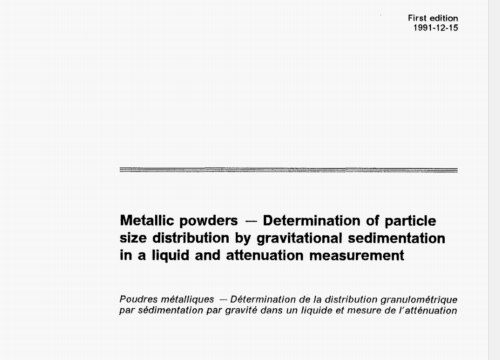ISO 10076 pdf download – Metallic powders一Determination of particle size distribution by gravitational sedimentation in a liquid and attenuation measurement.
6.2.2.4 QuantitatIve sedimentation with X-ray absorption
Quantitative tests are made with suspensions in different liquids and having different concentrations, starting for instance with a low concentration of 0.1 % (V/V). The best system is the one which gives the highest proportion of fine fractions.
6.2.3 Preparation of the suspension
6.2.3.1 The density and viscosity of the selected liquid at the test temperature shall be known or measured. The suspension may be prepared at the selected concentration, starting with a weighed test portion, or the suspending liquid may be added slowly and the powder worked to a paste, then diluted to a suspension. A drop of wetting agent shall be added to the dry test portion or the suspending liquid if the liquid does not readily wet the powder. Make up to an appropriate volume.
6.2.3.2 The dispersion may be made by shaking the suspension or stirring it in the sedimentation vessel. If necessary, treat with ultrasonics or dc-aerate under reduced pressure, either in a separate vessel or in the sedimentation vessel. The duration and Intensity of dispersion is selected so that unwanted agglomerates are destroyed but any aggregates or desired particles are not damaged.
6.3 SedimentatIon test
6.3.1 The general requirements for a satisfactory test are the following:
— the sedimentation cell shall be installed rigidly In a vertical position and without vibration;
— the cell shaH be fitted with a thermostatic envelope. or the environment conditioned to maintain the cell at a known temperature, stable to within ± 1 °C, with a rate of change of temperature of less than 0,01 C/min for prolonged analyses (longer than I h):
— care shall be taken to avoid convection currents in the liquid (due to evaporation or to external heat sources, for instance) and mass transfer currents (due to density inversion in the suspension).
6.3.2 Stir the suspension using either a stirring rod or a magnetic bar until the analysis is started
(1=0).
63.3 in most instruments, the initial optical density or X-ray absorption of the suspension is recorded.
This corresponds to 100 % cumulative undersize.
Before starting a test, the instrument is zeroed so that the optical density or X-ray absorption of the clear liquid corresponds to 0 %.
NOTE 1 It is recommended that certified reference powders be used for particle-size distribution determination by sedimentation, in order to check the accuracy and the correct working of the instrument.
7 ExpressIon of results
7.1 In photosedimentation, the optical density measurements give values of cumulative undersize by surface. These values are converted to cumulative undersize by mass for each Stokes diameter 4 corresponding to a time t. (See annex A for a worked example.)
7.2 In X-ray sedimentation, the X-ray absorption value is related directly to the mass concentration. I.e. to the cumulative undersize by mass
In some cases, it is convenient to present the results as a graph plotting cumulative undersize by mass on a linear scale from 0 % to 100 % as a function of Stokes diameter on a logarithmic scale. Presentation of the results on special graphs, such as lognormal plots or Rosin-Rammier coordinates diagrams, is allowed by agreement between the interested parties.
ISO 10076 pdf download – Metallic powders一Determination of particle size distribution by gravitational sedimentation in a liquid and attenuation measurement
